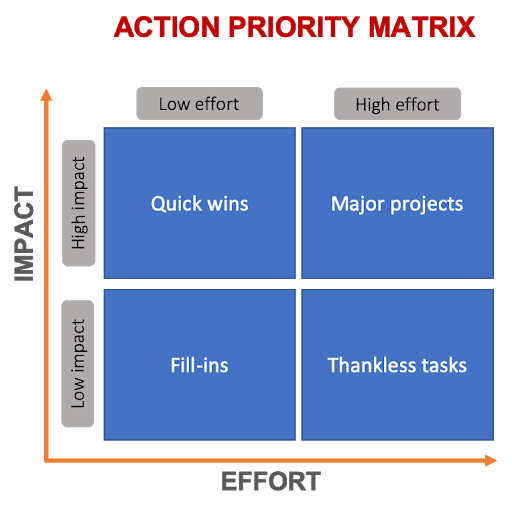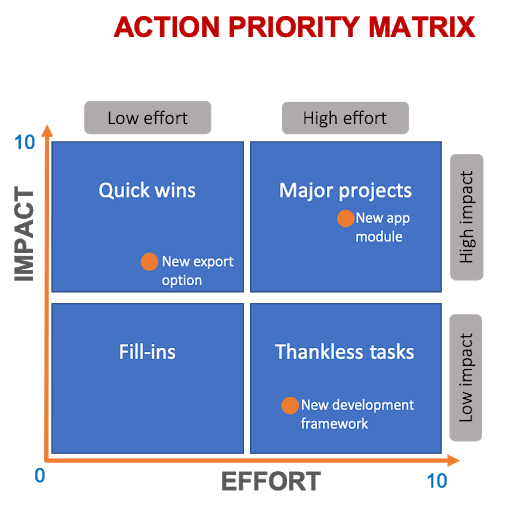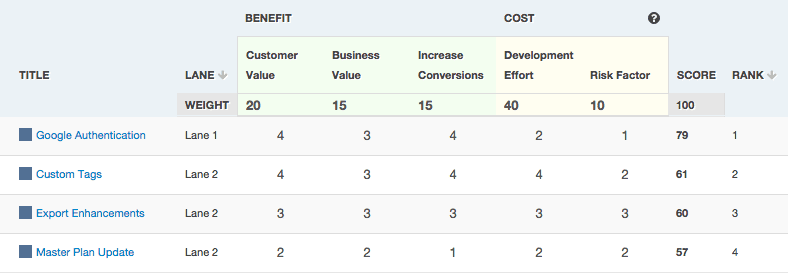What is an Action Priority Matrix?
An action priority matrix is a diagram that helps people determine which tasks to focus on, and in which order.
You create this matrix using two components. First, draw a graph that measures effort along the x-axis and impact along the y-axis. Next, add four boxes to the graph, two stacked on top of the others. With the finished diagram, you can plot all of your initiatives to see if they are high impact and low effort, high impact and high effort, low impact and low effort, or high impact and low effort.
What are the Four Categories of an Action Priority Matrix?
People typically classify these boxes as follows:
1. Quick wins (high impact, low effort)
2. Major projects (high impact, high effort)
3. Fill-ins (low impact, low effort)
4. Thankless tasks (low impact, high effort)
Your action priority matrix will look similar to the one shown here.

How can Product Managers Use an Action Priority Matrix?
After you’ve created your matrix, here is how to use it with your product team.
First step: List your initiatives
You can use a whiteboard or a presentation slide, or the Planning Board in ProductPlan’s web-based product roadmap software. The Planning Board looks like this:
Second step: Score each initiative
You can create any scoring scale, as long as you use the same method for all initiatives on your list. One common approach is a 0-10 score to measure both impact and effort. Tasks that your team scores 1-5, you’d rate low, and anything six or above would earn a high rating.
Third step: Plot your initiatives
When you’ve assigned both an impact and effort score for each task or project, you can start plotting them on your matrix. Here’s an example of a few items plotted on the action priority matrix for a software product team:

This team determined that adding an export option to its app would represent a 6.5 on the impact scale (high) and a 2.5 on the effort scale (low). Therefore, this placed the initiative in the quick-wins category.
Creating an entirely new module for its software app, the team agreed, would represent a high impact (8.1) but would also demand a lot of effort (6.8). With those scores, this initiative earned a place in the major-projects category of the matrix.
Fourth step: Prioritize the initiatives
The final step with your matrix is to decide how your team wants to prioritize and assign the projects you’ve scored and plotted. There is no single correct answer for how every product team should prioritize the order of its tasks.
Should you start with the quick wins or begin right away on the major projects? How many resources should you commit to fill-in projects? Should you devote any time or resources to the thankless tasks?
If completing a significant project will take all of your development resources. However, it represents such high-impact potential for your product or your business; you might need to forgo even the quick-win tasks and focus everyone’s attention on completing that major project.
But if your team decides you have a great deal of quick-win initiatives, and that those quick wins could add up to a combined high impact on your business, you might want to focus most of your resources on knocking out those quick wins first. This focus could help your team build momentum and enthusiasm, which will help them when it’s time to take on the difficult work of a significant project.
Keep learning how to balance planned and unplanned work in our webinar on setting priorities, below.
Want to learn more about prioritization? 
Related Terms:
prioritization / Eisenhower matrix / opportunity scoring / weighted scoring/ weighted shortest job first (WSJF)


